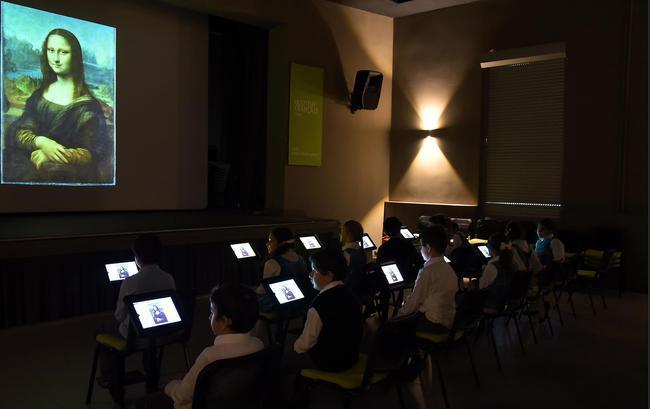
A cooperation between the French Cultural Institute in İzmir and Parc de la Villette, one of the largest cultural centers in Paris, has given İzmir its first “virtual museum” with 250 masterpieces from French cultural institutions.
The Ambassador of France to Turkey, Charles Fries, is seen making a tour in the virtual museum with masterpieces from French cultural institutions.
A cooperation between the French Cultural Institute in İzmir and Parc de la Villette, one of the largest cultural centers in Paris, has given İzmir its first “virtual museum” with 250 masterpieces from French cultural institutions.
“We like to think of it as a gateway to the public to a large collection of masterpieces that can be found at great French Museums, such as the Louvre, Musee d’Orsay, Chateau de Versailles, the Picasso Museum and the Pompidou Center, through a digital installation providing direct interaction with virtual explanations and games,” Didier Fuisillier, the director of la Villette, told Hürriyet Daily News when he came to open the museum in mid-December 2017.
Paris’ Institut de la Monde Arabe, a cultural center that specializes in Arab-Islamic culture and the Paris Philharmonic Orchestra are also included in this virtual museum project called “Micro-Folie,” which is literally translated as “Little Madness.”
“The virtual museum is an ever-growing project that combines many disciplines, from music to archaeology, from architecture to fine arts,” Rebecca Boulliou, the project officer of la Villette, explained.
“The visitor can just have a random tour, clicking on whatever grabs his fancy, or have a thematic tour designed for him or her,” said Boulliou.
One of the first visitors to the virtual museum was a group of students from Piri Reis, a French-language primary school. The group sat behind the screens in the institute’s cinema hall and started a joint virtual tour of the masterpieces, beginning with a teaser that combines architecture, archeology, music, dance and paintings in a quick-paced video.
This video enables the visitor to click on anything that catches their interest, thus starting an interactive journey in archeology, art or music. Since the projects’ launch last December, more than a thousand people, children and adults, have visited the projects.
This gives you a glimpse of the patrimony of mankind, not only French heritage,” explained Boulliou.
“There are archeological treasures from all around the world and works of art by international painters. When you take the pathway of archeology, you inevitably come across a Turkish treasure, or when you tour the arts section, it is not simply French painters but also [Spanish, Dutch or Middle Eastern] masters,” she said.
The project’s founders have underlined that the aim of the project is not to show off French culture but to create an ever-growing collection of the world’s patrimony. “We can very well imagine that some of Turkey’s lesser-known treasures in Turkish museums can become a part of the collection,” said Caroline David, the director of the French Institute of Culture, who has been an avid traveler around Turkey.
“I would consider the project to be a real success if, at the end of a year, we integrate 20 or more Turkish masterpieces. Imagine how rich Turkey is in terms of Greek-Roman archeological heritage or the great variety of the Turkish carpets. Why not add some of them to the virtual museum?” said David.
For David, the French cultural institutes in the world, with their mediatheques, exhibition and conference halls, are a good platform to draw in both students and adults to a virtual museum. The İzmir French Cultural Institute might be the first of a larger project.
Didier Fuisillier said the virtual museums are not a replacement of “real treasures” in museums. On the contrary, they aim to encourage
people to see the real thing by creating awareness of their existence, he said.
“Virtual museums also enable people to see some of the heritage in more detail,” pointed out Boulliou.
“You might go to the Louvre to see the Mona Lisa, but chances are you will be surrounded by other tourists who get in your way in their attempts to get a glimpse. Here, you can can observe it from all angles and read the explanations at your leisure,” she said.
The rise in virtual museums around the world has increased over the 21st century due to a variety of reasons—for the western world, it is a way of drawing in the screen-addicted younger generation and to beat the high cost of moving around masterpieces.
For the Middle East, it is simply a way to recover lost antiques. In Iraq, for example, some of the antiques looted from the legendary National Museum of Iraq in Baghdad after 2003 will come to life in a virtual museum.